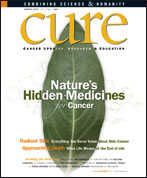Publication
Article
CURE
Science of Suncreen
Author(s):
Improvements to sunscreen and other sun-protection methods in development can help reduce the risk of skin cancer.
Almost 80 years after the first commercial sunscreen was developed in the United States, staying out of the sun is still the best protection against UV rays, but total avoidance is nearly impossible.
Consistent use of sunscreen lotion with an adequate sun protection factor (SPF) can greatly reduce the risk of skin cancer. Although sunscreen and sunblock protect the skin, ingredients vary. Chemical protectants absorb most ultraviolet rays before reaching the skin, while physical blocks contain tiny particles that act as a mirror that bounces UV rays off the skin.
The strength of sunscreens are determined by SPF, the measurement of UVB protection. SPF is the ratio of the time it takes for UV exposure to produce minimal erythema (reddening of the skin) in protected skin versus unprotected skin. Therefore, a sunblock with an SPF of 15 means it takes the skin 15 times longer to begin turning red than if it was unprotected. While the level of protection needed varies according to skin type and duration of time in the sun, experts recommend an SPF between 15 and 30 that is reapplied every few hours and after water activities, even if the product is labeled “waterproof.” Because sunblock needs time to bind to the skin, experts recommend applying it 30 minutes before sun exposure. Otherwise, it can wash off easily with water or sweat.
Studies have shown people apply at least 25 percent less sunblock than needed to receive the full SPF. Sunblocks that have higher than SPF 30 offer only a negligible amount of additional protection. Sunblocks that guard against both UVA and UVB, called broad-spectrum, are more effective against damage that may cause skin cancer. While researchers believe UVB causes skin cancer and premature aging, new research shows that UVA may also cause cancer, including melanoma. Sunblock ingredients that protect against UVA include zinc oxide, titanium dioxide, oxybenzone and avobenzone.
Modern methods of filtering UV rays await approval from the Food and Drug Administration, including a chemical called TDSA that protects against UVA and doesn’t degrade when exposed to UV radiation. Scientists are also researching oral agents. A dietary supplement called carotenoid astaxanthin has anti-inflammatory and antioxidant benefits, which may protect against UVA-induced DNA damage. Another supplement in testing to protect against UV damage is a sun protectant pill that would protect the entire body by adding another layer of protection.





